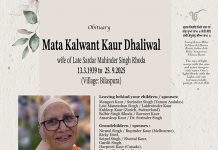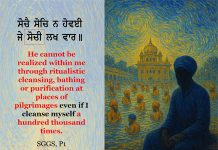
By Karminder Singh Dhillon | Opinion |
Dead men tell no tales. By extension then, they also write no essays. All the telling and writing – including about one’s death – has to be done while one is alive. So here is mine.
The first narrative that must be told is the obvious one; namely that billions of people could have been born and lived in my place. For all I know, they could have done so much better than me. So, the very fact that I lived my life as such is great in itself.
Every anxiety that life is coming to an end, or has come to an end; can be overcome by the simple assertion “but I did live, and that I did have the opportunity called human life on this wonderful planet.” The probability that I would not have existed is infinitely higher than the one that I did exist. The prospect that someone else could have lived a more productive life than mine is similarly high, very high indeed.
Sure, I suffered loss, pain, and felt let down. But when compared to the infinity of the universe – all of thatpain and agonies combined is a drop in the ocean.
FOR MORE ARTICLES ON DEATH, GO HERE
In realization of the above realities, I expect that my death will be accompanied by no fear, no sadness and no regret. I will need the profound silence within which I should be able to say “I have accomplished my task to the best of my abilities.” My task was not to gain fame, followers, or supporters. Neither was it to change, transform or alter anyone’s life. My task was merely to point a finger towards the counsel and messages of Guru Nanak, and it did not even require checking if anyone was listening, reading, looking or watching. The person pointing the finger does not matter. What matters is what it is being pointed at. What is meant to be seen for ourselves is not the finger, but the object of its pointing. After all, pointing to something that has always been there since 1469 required no feat at all.
Someone once asked me what I expected death to be like and if I believed in an afterlife or reincarnation. I said that my ending would not be any different from the switching off of a light bulb, or the falling of a leaf from a tree. Simple, neat, un-eventful and final. No one asks if the light that was switched off, or the leaf that fell off reincarnates.
IMMEDIATELY UPON DEATH
1. The Washing, Cleaning And Dressing Up Of A Corpse. Guru Arjun ji has this couplet in Gurbani.
ਜੇ ਮਿਰਤਕ ਕਉ ਚੰਦਨੁ ਚੜਾਵੈ ॥ ਉਸ ਤੇ ਕਹਹੁ ਕਵਨ ਫਲ ਪਾਵੈ ॥
ਜੇ ਮਿਰਤਕ ਕਉ ਬਿਸਟਾ ਮਾਹਿ ਰੁਲਾਈ ॥ ਤਾਂ ਮਿਰਤਕ ਕਾ ਕਿਆ ਘਟਿ ਜਾਈ ॥੩॥
Jay Mertak Kao Chandan Chrravaiy. Us Tay Kho Kavan Ful Pavaiy?
Jay Mertak Kao Bestta Mahe Rulayi. Ta(n) Mertak Ka Kya Ghatt Jayi. SGGS 1160
Meaning: If A Deceased Person Is Adorned With The Fragrance Of Sandalwood; What Benefit Would The Deceased Obtain From It? If A Deceased Was Mixed Up In Filth; Then What Detriment Would The Deceased Suffer.
It’s a foundational critique of the efforts people make, to dress up and present their deceased loved ones to the world. These efforts range from washing and dressing up the dead, to transforming the deceased by paying morticians to display their skills at turning the corpse of a 90-year-old into that of a 19-year-old.
There would thus be no need no need to wash my body, no need to dress it in my best clothes and put on a new pair of leather shoes for me. Please give them to the needy. I would go in the clothes and shape I died in.
For those who will point to the Sikh Rehat Maryada (SRM) and say that washing a dead body is stipulated, I would not mind even one bit, if my own critique against the SRM is used against me: the SRM is man made, chunks of it is plagiarized from the rituals of other religions, and its stipulations cannot supersede the divine counsel of Gurbani (as found on page 1160 above, for instance).
2) The All-Mighty Wake. There will be no need for a wake. People who have never come to see me for years will show up. People who didn’t want to see me ever will show up. Why will I need these people to come see my dead body? It is not that I will wake up to acknowledge them. More likely than not they would have come to make sure I did not wake up.
3) The Euphemism Of Last Respects. There will be no need for last respects either. All the respect that I earned was already given to me in my life by those who mattered. Why would I want people who cannot remember when they paid respect to me prior to this “last respect” to come and pay their “last respects?”
THE PROCESSES AFTER DEATH
1) The Sehej Path or Akhand Path Ritual. There will be no need for any kind of patth – sehej, akhand or Sukhmani. The recitation of patth for dead people is no more than a ritual. Any kind of patth read or recited on my behalf would be worthless to me once I am dead. If fact, any kind of patth read on my behalf when I was alive is also worthless. The only Gurbani reading that mattered was the one I read on my own, by myself for myself; and for the purpose of getting to its messages and putting those messages to practice in my life. None of this can be done after I am dead – so why allow the ritual and charade of doing patth to “assist me in my afterlife” to take place? How can anyone assist – in the hereafter – one who never believed in an “afterlife” for his or her whole life in the here and now?
2) The Ubiquitous Antim Ardas. The “antim” (final) ardas of us Sikhs is anything but “antim”. Nowhere else does one see an avalanche of ardas after ardas but during the death of our loved ones. There is the ardas before washing the deceased. There is the ardas upon the hearse leaving the house or wake. There is an ardas upon arriving at the cremation grounds. There is an ardas upon lighting the pyre. When everyone is prepared to leave the cremation grounds, there is an ardas after the completion of Sohela. The family, friends and relatives then stop over at the local gurdwara for an ardas on behalf of the deceased and the start of a sehej patth. Three days after the cremation, there is an ardas before and another ardas after the remains are collected for disposal. At the disposal site, there is an ardas. If the remains are kept for disposal at special or “holy” site, there will another ardas there. For the patth that is being recited by hired clergy on behalf of the deceased (akhand or sehej) there is a beginning ardas, a mid-point (madh dee ardas) and a completion ardas. On the day of bhog ceremony there will be what is euphemistically called an antim ardas. But that is a euphemism, because it is anything but antim (final). This same ardas will be repeated at every barsi for the next 10, 20 or 30 years. It is, as if no one believed in the antim ardas – or any other ardas for that matter – in the first place. For, if indeed the antim ardas was final, then why are there 10, 20 or 30 more of the same at every barsi?
SEE ALSO: The Concept of Reincarnation in Sikhi and Sikhism – Advocated or Precluded?
So, there will be no need for any kind of “antim ardas” over my dead body, or in anything related to my death.
It follows that there will be no need for a dasveen, starveen or barsi or any kind of program relating to my death – in a Gurdwara. For the most part of my life I expressed my beliefs that when it comes to preaching Gurbani, Gurmat and Sikh, the Gurdwara was the headquarters for hijacked Sikhi. For some 2 decades, I have stopped going to Gurdwaras for my own spiritual development because much of what goes on therein contravenes the principles of Gurbani. If I do go, it’s for social purposes – an anand karaj or a marag da bhog of family members. I have told my three children that to be genuine Sikhs – they need to stop expecting the Gurdwara to help them in their Gurbani and Sikhi progress. I tell them that all the corrupted stuff about Sikhism that I had acquired came from the Gurdwaras that I attended for the first 45 years of my life. So why should I be dragged into a Gurdwara after I have died?
3) Obtaining Closure By My family. Closure upon the death of a loved one, family member or a friend does have a place in life and living. Family members, friends and appreciators of the work I did, and content I created and posted in the form of books, videos, essays etc. on the two websites www.sikhivicharforum.org and www.sikhbulletin.com are welcome to hold a memorial seminar or get together in any suitable location, should they feel a need to. At this get-together, they could play my latest video for the audience, have people who are familiar with my work talk about it, and put out my books for distribution. They could have a meal or refreshment to celebrate my work. This is a befitting memorial – far more meaningful than gathering in a Gurdwara that would necessitate the clergy – who don’t know me at all – have the last word on me. Those who are familiar with my views know that with few exceptions, our earn-a-living clergy is one group of people that I hold most responsible for the corruption and distortion that has befallen Sikhi today. Why would I want them as part of my memorial function?
4. No Eulogies Needed. There is undoubtedly a whole psychology at work behind our craving for eulogies. It is indicative of a strangeness that lurks in human nature. A person could be lying on his bed, sick and lonely, and the only visitors he gets may be the occasional family member, health care worker, or the cleaning lady. But the moment he kicks the bucket, people crawl out of the woodwork to race each other into delivering Oscar-worthy speeches about what a “gem of a person” the dead person was. “He lit up the room. He was the greatest soul alive. He touched so many lives. Life would never be the same without him. The community has lost an irreplaceable human being…” The list is as long as it is pretentious.
It seems that human beings have a strange penchant of remembering people after they’re gone. It also seems like people love to pay tributes, but only when the person can’t hear them anymore. Bhagat Kabir says it this way:
ਜੀਵਤ ਪਿਤਰ ਨ ਮਾਨੈ ਕੋਊ ਮੂਏਂ ਸਿਰਾਧ ਕਰਾਹੀ ॥
Jeevat Pitar Na Manaiy Kou Muey Seradh Krahi. SGGS 332.
Meaning: When Alive, Even Parents Are Not Recognized As Such, But Upon (Their) Death, All The Rituals Meant To Honor Ancestors Are Undertaken.
No one cares much for people in their lives, but the day he or she dies, people suddenly remember all the good times they had with the deceased; even if the last “good time” was in duapur or treyta. The irony? They’ll travel miles, cancel meetings, and even take leave from work to attend the funeral of the person they rarely visited when he or she was alive.
I know I can dispense a whole dishwasher load of advice here: “People don’t need your tributes when they’re gone, they need your support now. If you truly care about someone, prove it while they can still appreciate it. Show love today, not at the funeral…blah blah blah.”
But I know that the psychology pertaining to eulogies will not change, no matter how good the advice. So, a “no eulogy” sign at every and any event connected to my death – from the simple announcement to the even simpler memorial – will be appropriate.

Sikh thinker, writer and parcharak Karminder Singh Dhillon, PhD (Boston), is a retired Malaysian civil servant. He is the joint-editor of The Sikh Bulletin and author of The Hijacking of Sikhi. This article appeared in The Sikh Bulletin – Vol 27, No 3 (July – September 2025). Click here to retrieve archived copies of the bulletin. The author can be contacted at dhillon99@gmail.com.
RELATED STORY:
There is no second coming (Asia Samachar, 15 July 2023)
ASIA SAMACHAR is an online newspaper for Sikhs / Punjabis in Southeast Asia and beyond. You can leave your comments at our website, Facebook, Twitter, and Instagram. We will delete comments we deem offensive or potentially libelous. You can reach us via WhatsApp +6017-335-1399 or email: asia.samachar@gmail.com. For obituary announcements, click here


































When I Die……One of the best, if not the best writing I have come across on the subject of death.
Every word is in line with the Gurbani.
There is so much of showmanship after death, that the ‘dead’ wouldn’t belief. ( if he can see).
Its how you treat the person when he/she is alive, as quoted by S Karminder Singh Ji…”Jivet Piter Naa Maneh……..” so let us wake up and lead a Gursikh life and keep away from all the Showmanship.( Dikhavaa).
Thanks Bhai Sahib Karminder singh Ji. May we hear more from you. Gurfateh
Very interesting thoughts by Sr Dhillon, which I largely agree with. According to both Sikh teaching and an scientific reasoning, any number of rituals and prayers, no matter how elaborate, have no material impact on the deceased. In Sikhi, for example, the Gurus make it clear that once the soul has departed, it is no longer bound to the physical body, and no external ritual can alter its journey. Instead, the emphasis is placed on living a righteous and mediative life while one is alive. In this sense, death according to Gurbani is not a physical process as such, but a state of mental awareness.
Where I disagree with Dr Dhillon is the suggestion that all death rituals are performed for the deceased. In reality, these prayers and associated rituals are primarily for those who remain – family, friends, and community members – to help them process loss, express grief, and find a sense of closure. Whether it is the antim ardaas in Sikhii, the janazah prayer in Islam, or the Christian funeral service, these acts serve as collective moments of reflection, solidarity, and comfort for the living.
Across traditions, these ceremonies form part of a natural bereavement process, helping individuals navigate the complex emotions that follow death. They create a structured space to acknowledge loss, share memories, and reaffirm spiritual truths about the nature of life and mortality. In that sense, while the deceased may be beyond the reach of human ritual, the living are profoundly shaped by them.
Comments are closed.